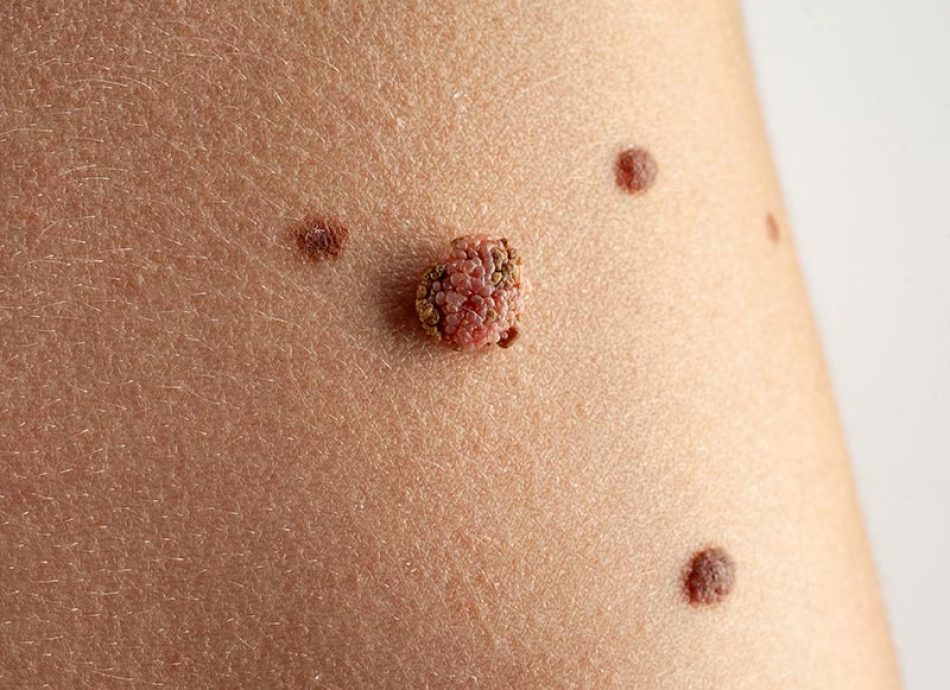Malignant melanoma is the most serious type of skin cancer, arising from melanocytes, the pigment-producing cells in the skin. While less common than other skin cancers, melanoma is highly aggressive and can spread rapidly if not diagnosed early. Understanding its causes, symptoms, stages, and treatment options is crucial for effective management and improved prognosis.

Causes and Risk Factors
Melanoma develops due to genetic mutations in melanocytes, often triggered by excessive ultraviolet (UV) radiation exposure. Risk factors include:
- Excessive Sun Exposure: Prolonged UV radiation from sunlight or tanning beds increases risk.
- Fair Skin and Light Hair: Individuals with less melanin are more susceptible.
- Family History: A genetic predisposition may increase susceptibility.
- Weakened Immune System: Conditions that suppress immunity heighten risk.
- Multiple or Atypical Moles: People with numerous or irregular moles have a higher likelihood of melanoma.
- Severe Sunburns in Childhood: Past blistering sunburns significantly raise lifetime risk.
Symptoms of Malignant Melanoma
Early detection is key to successful treatment. Melanoma symptoms often follow the ABCDE rule:
- A – Asymmetry: One half of the mole differs from the other.
- B – Border Irregularity: Edges appear uneven or blurred.
- C – Color Variation: Presence of multiple colors within the lesion.
- D – Diameter: Lesions larger than 6mm are concerning.
- E – Evolving: Any changes in size, shape, color, or new symptoms like bleeding or itching.
Stages of Melanoma
Melanoma progression is categorized into five stages:
Stage 0 (In Situ)
- Confined to the epidermis.
- Highly curable with early removal.
Stage I
- Tumor thickness: ≤2mm.
- No ulceration or lymph node involvement.
Stage II
- Tumor thickness: 2–4mm with or without ulceration.
- No lymph node spread.
Stage III
- Cancer has spread to nearby lymph nodes.
- Higher risk of recurrence post-treatment.
Stage IV
- Metastasis to distant organs (lungs, liver, brain, bones).
- Requires aggressive treatment.
Diagnosis and Screening
Physical Examination
Dermatologists evaluate suspicious moles using dermoscopy to detect early signs.
Biopsy Procedures
- Excisional Biopsy: Entire lesion removal for detailed examination.
- Punch Biopsy: Sampling deeper skin layers.
- Sentinel Lymph Node Biopsy: Determines cancer spread to lymph nodes.
Imaging Tests
For advanced cases, imaging such as MRI, CT scans, and PET scans assess metastasis.
Treatment Options
Treatment varies based on melanoma stage and may include:
Surgical Excision
- Primary treatment for early-stage melanoma.
- Wide local excision ensures complete removal.
Immunotherapy
- Checkpoint Inhibitors: Drugs like pembrolizumab and nivolumab boost immune response.
- Interleukin-2 Therapy: Enhances immune activity against melanoma cells.
Targeted Therapy
- Effective for melanomas with BRAF mutations.
- Drugs: Dabrafenib and trametinib block abnormal cell growth.
Radiation Therapy
- Used for inoperable melanomas or metastatic cases.
- Helps relieve symptoms and slow progression.
Chemotherapy
- Less common due to advancements in targeted therapy and immunotherapy.
- May be used for widespread metastasis.
Prevention Strategies
While genetic predisposition cannot be altered, preventive measures can reduce risk:
- Use Sunscreen Daily: SPF 30+ provides protection.
- Avoid Tanning Beds: UV exposure significantly raises risk.
- Wear Protective Clothing: Long sleeves, hats, and sunglasses shield skin.
- Regular Skin Checks: Self-examinations and dermatologist visits help early detection.
Prognosis and Survival Rates
Prognosis depends on early detection and stage at diagnosis:
- Stage 0 & I: 5-year survival rate exceeds 95%.
- Stage II: 60–80% survival rate.
- Stage III: 40–70% depending on lymph node involvement.
- Stage IV: Less than 30%, but improving with advanced treatments.
Malignant melanoma is a severe yet preventable form of skin cancer. Early detection through self-examination and regular screenings significantly enhances survival rates. With advancements in immunotherapy and targeted treatments, melanoma patients have better prognoses than ever before. Awareness and proactive skin protection are key in the fight against this aggressive disease.